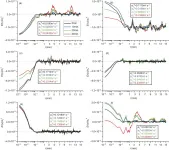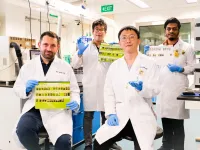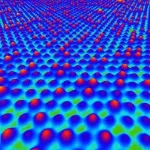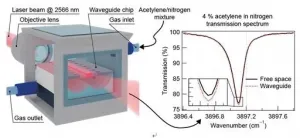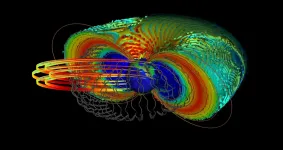Tracking cells with omnidirectional visible laser particles
2021-02-02
(Press-News.org) Laser particles are micrometre and nanometre lasers in the form of particles dispersible in aqueous solution, which have attracted considerable interest in the life sciences as a promising new optical probe. Laser particles emit highly bright light with extremely narrow spectral bandwidth. By transferring laser particles into live cells as shown in Figure 1, individual cells in a heterogeneous population can be tracked using each intracellular particle's specific spectral fingerprint as an optically readable barcode. However, laser particles emit directional light (Figure 2) and freely tumble inside living cells, their orientation varying randomly over time. Therefore optical readout of these labels results in "lighthouse-like" blinking, leading to frequent loss of cell traces.
In a new paper published in Light: Science & Application, scientists from Professor Seok-Hyun Yun's group at Harvard Medical School, and Professor Yun-Feng Xiao's group at Peking University demonstrate single-cell tracking with intracellular laser particles engineered to emit nearly homogeneously in all directions. The omnidirectional laser emission is achieved by incorporating light scattering into the microdisk cavity, which reduces orientation dependent intensity fluctuations by two orders of magnitude (Figure 2), enabling blinking-free tracking of single cells under the same conditions where existing technology suffers from frequent tracking failure. The reported technique will open new avenues for large-scale single-cell analysis, and facilitate other applications of laser particles, such as cellular and biochemical sensing and single-cell analysis in microfluidics.
These scientists summarize the single-cell tagging principle of laser particles:
"Typically, researchers use fluorescent probes to label specific cells, but only a few colors can be used at the same time before spectral overlap becomes a problem. Laser particles are tiny lasers that can be inserted inside living cells. These tiny lasers can be designed to produce many more distinguishable colors. The intracellular laser particles with a specific color will move with live cells, and therefore single cells can be tracked as they move throughout complex biological samples," said Dr. Shui-Jing Tang, a former visiting student at Harvard Medical School and a current Boya postdoctoral researcher at Peking University.
"Unfortunately, laser particles emit light in a specific direction. When particles rotate freely over time as the cell moves, their apparent brightness, as seen by a photodetector, changes dramatically. We developed a new kind of laser particle emitting light in all directions. Therefore, the spatial cell traces could be tracked continuously no matter how each particle was oriented inside a cell," added Paul Dannenberg, a graduate student at Harvard Medical School.
"The presented technique makes it possible to detect and identify laser particles reliably over time in cell tracking applications, which could enable large-scale single-cell analysis in complex biological specimens. In addition to cell-tracking, our work will facilitate other applications of laser particles, such as cellular and biochemical sensing and single-cell analysis in microfluidics," said Dr. Andreas Liapis, a research fellow at Harvard University.
INFORMATION:
[Attachments] See images for this press release:
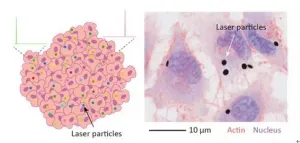
ELSE PRESS RELEASES FROM THIS DATE:
2021-02-02
Loess Plateau possesses a particular loess physiognomy with numerous ravines and slopes, and tableland is a typical landform in it. Together, the ununiform in both topographic undulation and land coverage compose the ununiform, complex underlying surface on Loess Plateau. This provides a special platform for research of turbulence above the complex underlying surface.
As the front-edge problem encountered in the atmospheric boundary layer thesis, the turbulence research for complex underlying surface has drawn extensive attention recently. Local similarity has already proven that under certain condition, theories of turbulence based on the uniform underlying surface can also be applied to which for the ununiform underlying surface. ...
2021-02-02
A team from Nanyang Technological University, Singapore (NTU Singapore) has developed a portable device that produces high-resolution 3D images of human skin within 10 minutes.
The team said the portable skin mapping (imaging) device could be used to assess the severity of skin conditions, such as eczema and psoriasis.
3D skin mapping could be useful to clinicians, as most equipment used to assess skin conditions only provide 2D images of the skin surface. As the device also maps out the depth of the ridges and grooves of the skin at up to 2mm, it could also help with monitoring wound healing.
The device presses a specially devised film onto the subject's skin to obtain an imprint of up to 5 by 5 centimetres, which is then ...
2021-02-02
A satellite-based dataset generated by KAUST researchers has revealed the dynamics of dust storm formation and movements over the last decade in the Arabian Peninsula. Analysis of this long-term dataset reveals the connection between the occurrence of extreme dust events and regional atmospheric conditions, a finding that could help improve weather forecasting and air-quality models.
Dust storms occur when strong winds lift tiny particles of sand into the atmosphere. These events often span several miles and can have an enormous impact on daily life, from damaging buildings and disrupting air traffic to triggering respiratory illnesses and other health problems.
The Arabian Peninsula is a global hotspot of extreme dust events, with storms occurring ...
2021-02-02
Residential gardens are a poor substitute for native bushland and increasing urbanisation is a growing threat when it comes to bees, Curtin University research has found.
Published in 'Urban Ecosystems', the research looked at bee visits to flowers, which form pollination networks across different native bushland and home garden habitats.
Lead author, Forrest Foundation Scholar Miss Kit Prendergast, from Curtin's School of Molecular and Life Sciences said the findings highlight the need to prevent destruction of remaining bushland and preserve native vegetation, in order to protect sustainable bee communities and their pollination services.
"Our study involved spending hundreds of hours at 14 sites on the Swan Coastal Plain at Perth, Western Australia, ...
2021-02-02
Researchers have shown how disposable face masks could be recycled to make roads, in a circular economy solution to pandemic-generated waste.
Their study shows that using the recycled face mask material to make just one kilometre of a two-lane road would use up about 3 million masks, preventing 93 tonnes of waste from going to landfill.
Developed by researchers at RMIT University in Melbourne, Australia, the new road-making material is a mix of shredded single-use face masks and processed building rubble designed to meet civil engineering safety standards. ...
2021-02-02
Researchers from Peter the Great St.Petersburg Polytechnic University (SPbPU) in collaboration with colleagues from Belgium take a step in the development of genome editing technology. Currently it is possible to deliver genetic material of different sizes and structures to organs and tissues. This is the key to eliminating DNA defects and treating more patients. The project is guided by Professor Gleb Sukhorukov and supported by the Russian Science Foundation. Research results were published in Particle & Particle Systems Characterization journal.
An international research group developed a polymer ...
2021-02-02
Semiconducting 2D alloys could be key to overcoming the technical limitations of modern electronics. Although 2D Si-Ge alloys would have interesting properties for this purpose, they were only predicted theoretically. Now, scientists from Japan Advanced Institute of Science and Technology have realized the first experimental demonstration. They have also shown that the Si to Ge ratio can be adjusted to fine tune the electronic properties of the alloys, paving the way for novel applications.
Alloys--materials composed of a combination of different elements or compounds--have played a crucial role in the technological development of humans since the Bronze Age. Today, ...
2021-02-02
The Bronze Age (2200 to 800 BC) marked a decisive step in the technological and economic development of ancient societies. People living at the time faced a series of challenges: changes in the climate, the opening up of trade and a degree of population growth. How did they respond to changes in their diet, especially in Western Switzerland? A team from the University of Geneva (UNIGE), Switzerland, and Pompeu Fabra University (UPF) in Spain has for the first time carried out isotopic analyses on human and animal skeletons together with plant remains. The scientists discovered that manure use had become widespread over time to improve crop harvests in response to demographic growth. The researchers also found that there had ...
2021-02-02
Optical waveguides suspended in air are capable to beat free-space laser beams in light-analyte interaction even without complex dispersion engineering. This phenomenon has been predicted more than 20 years ago, yet never observed in experiment.
In a new paper published in Light Science & Application, a team of scientists, led by Professor Jana Jágerská from Department of Science and Technology, UiT The Arctic University of Norway, and co-workers have devised a mid-infrared free standing solid core optical waveguide which pushes the light interaction with the surrounding air beyond what has been reported up until now: 107 % interaction strength compared to that of a free-space beam has been demonstrated.
"The guided mode of our thin waveguide ...
2021-02-02
New study found that electrons can reach ultra-relativistic energies for very special conditions in the magnetosphere when space is devoid of plasma.
Recent measurements from NASA's Van Allen Probes spacecraft showed that electrons can reach ultra-relativistic energies flying at almost the speed of light. Hayley Allison, Yuri Shprits and collaborators from the German Research Centre for Geosciences have revealed under which conditions such strong accelerations occur. They had already demonstrated in 2020 that during solar storm plasma waves play a crucial role for that. However, it was previously unclear why such high electron energies are not achieved ...
LAST 30 PRESS RELEASES:
[Press-News.org] Tracking cells with omnidirectional visible laser particles
